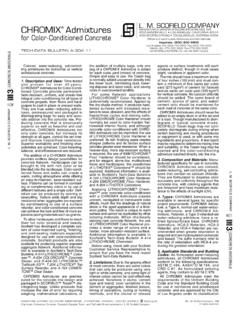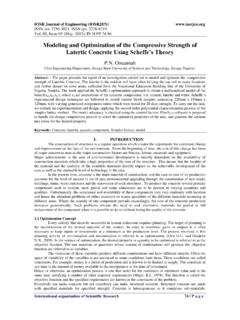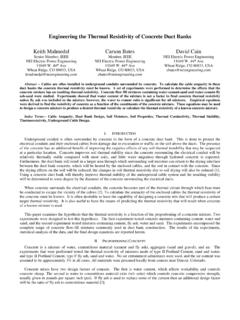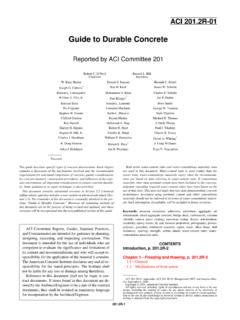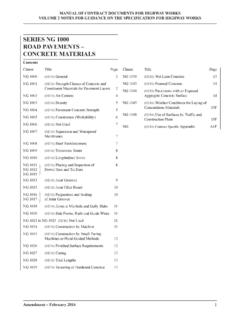Transcription of 10.102 Pozzolanic Reactivity - bigfreshcontrol.com
1 Pozzolanic ACTIVITY INDEX. (COMPRESSIVE STRENGTH OF MORTARS). High Reactivity Metakaolin (HRM). Engineered Mineral Admixture for Use with Portland cement Advanced cement Technologies' PowerPozz High Reactivity Metakaolin is a manufactured Pozzolanic mineral admixture which significantly enhances many performance characteristics of cement -based mortars, concretes and related products. PowerPozz , derived from purified kaolin clay, is a white, amorphous, alumino-silicate which reacts aggressively with calcium hydroxide, a normal cement hydration byproduct, to form compounds with cementitious value. Testing Program Advanced cement Technologies has performed an evaluation of the performance of PowerPozz HRM in cement mortars. The purpose of the testing (in accordance with ASTM C-311 / ASTM C-618) was to demonstrate the Pozzolanic activity index of PowerPozzTM HRM over that of a control, or in some cases, as compared to other pozzolans.
2 The evaluations, conducted at the facilities of AGRA Earth and Environmental in Vancouver, , Canada, were conducted in three phases: In Phase 1, PowerPozz was used in varying concentrations (5,10, 15%) and compared to the same concentrations of silica fume and to a plain cement control. Strengths and the variations in required superplasticizer dosage were examined. Pozzolanic ACTIVITY INDEX. (COMPRESSIVE STRENGTH OF MORTARS). In Phase 2, the mixes were produced with a range of different pozzolans, including PowerPozz without superplasticizers. The water addition and therefore water to binder ratios were allowed to vary to achieve similar flows. Effects on water demand and strength were examined. In Phase 3, the compressive strength of a plain cement mortar was compared with the strength gain of a mortar in which 10% of the cement was replaced with PowerPozzTM HRM.
3 In this study, a dry superplasticizer was added to both the control and the test mixes at a constant dosage. Both the control and test mixes were produced at a water / binder ratio of and a sand / binder ratio of Compressive strengths presented are the averages for 3 cubes at each of the 4 age intervals (1,3,7,28 days). PHASE 1. Methodology In this study, 9 mortar mixes were produced: Two of the mixes were Class F. Flyash/HRM combinations and will be reported separately. For the remaining 7 mixes, the following cementitious materials were used: Mix 1: Type 1 Ordinary Portland cement (Control). Mix 2: OPC / 5% PowerPozz HRM. Mix 3: OPC / 10% PowerPozz HRM. Mix 4: OPC / 15% PowerPozz HRM. Mix 5: OPC / 5% Silica Fume Mix 6: OPC / 10% Silica Fume Mix 7: OPC / 15% Silica Fume 2. Advanced cement Technologies, LLC.
4 435 Martin Street, Suite 2040 Blaine, WA 98231. Tel: (360) 332-7060 Fax: (360) 332-9321. Pozzolanic ACTIVITY INDEX. (COMPRESSIVE STRENGTH OF MORTARS). The percentages of supplementary cementing materials were replacements by weight of portland cement , not additions. The mortars were produced with a water : binder ratio of The compressive strength results reported are the averages of two cubes Phase 1 Results Results from Phase 1 are reported in Table 1. Project: Comparative Strength Testing of PowerPozz High Reactivity Metakaolin Subject: Strength Activity Index with Portland cement (ASTM C-311). TABLE 1. Phase 1. TEST DATA. Mix 1 Mix 2 Mix 3 Mix 4 Mix 5 Mix 6 Mix 7. Control 5% PP 10% PP 15% PP 5% 10% 15%. Materials HRM HRM HRM Silica Silica Silica Fume Fume Fume Type 1 cement (g) 667 633 600 567 633 600 567.
5 PowerPozzTM (g) _. 34 67 100 _ _ _. _ _ _ _. Silica Fume (g) 34 67 100. Standard Sand 1428 1428 1428 1428 1428 1428 1428. Superplasticizer, Daxad 199g) Water (g) 267 267 267 267 267 267 267. W/C Ratio Flow, at 15 drops of flow table (%) 115 115 115 120 110 125 115. 3. Advanced cement Technologies, LLC. 435 Martin Street, Suite 2040 Blaine, WA 98231. Tel: (360) 332-7060 Fax: (360) 332-9321. Pozzolanic ACTIVITY INDEX. (COMPRESSIVE STRENGTH OF MORTARS). TEST. RESULTS. Compressive Strength (Mpa) Strength Activity Index @ 24 hrs. Compressive Strength (Mpa) Strength Activity Index @ 3 Days Compressive Strength (Mpa) Strength Activity Index @ 7 Days Compressive Strength (Mpa) Strength Activity Index @ 28 Days Compressive Strength (Mpa) Strength Activity Index @ 56 Days *56 day results are based on 1 cube only Phase 1 Results & Discussion The results show that both mineral admixtures show progressive increases in strength with increasing percentages of replacement, up to the 15% level.
6 With PowerPozz at 5% replacement, the strength increase is 10% over control. At 10% and 15% replacements, PowerPozz contributed to 22%. and 28% gains respectively as compared to the control mix. The results indicate that increasing loading rates of PowerPozz contribute to higher strengths. These results also indicate that PowerPozz is most efficient within the range of 10 + 2%. At 5% PowerPozz , a 2% increase in strength is realized per percent PowerPozz . This increases to a increase in strength per percent PowerPozz at 10% replacement and decreases slightly to per percent PowerPozz at the 15% replacement level. 4. Advanced cement Technologies, LLC. 435 Martin Street, Suite 2040 Blaine, WA 98231. Tel: (360) 332-7060 Fax: (360) 332-9321. Pozzolanic ACTIVITY INDEX. (COMPRESSIVE STRENGTH OF MORTARS). In comparing the PowerPozz HRM mixes to those produced with silica fume, PowerPozz mortars were generally stronger at three days, approximately the same at seven days and slightly lower at 28 days.
7 These results show that PowerPozz is comparable to silica fume in terms of compressive strength development but does so with a much lower water demand. Therefore, the PowerPozz mortars required a significantly lower (half) dosage of superplasticizer to maintain flow and stable water: cementitious ratio. The Pozzolanic activity results without the use of superplasticizers are examined in Phase 2. It was observed that with PowerPozz being white in color, it produced mortars which were fairly normal in appearance, whereas those produced with silica fume had a characteristic dark gray color. PHASE 2. Methodology In the second study, the mortars were produced in accordance with ASTM C-311. One control (plain OPC) mix was produced, and all other supplementary cementing materials were used at replacement by weight of cement .
8 Five mixes are reported here. Of the five mixes one was the control, one included silica fume, and three were produced with metakaolins. Of the three HRM products used, one is PowerPozz , and the other two are other commercially available metakaolins. 5. Advanced cement Technologies, LLC. 435 Martin Street, Suite 2040 Blaine, WA 98231. Tel: (360) 332-7060 Fax: (360) 332-9321. Pozzolanic ACTIVITY INDEX. (COMPRESSIVE STRENGTH OF MORTARS). Mix 1: OPC - Ordinary Portland cement (Control). Mix 2: OPC / Metakaolin A. Mix 3: OPC / Metakaolin B. Mix 4: OPC / PowerPozz . Mix 5: OPC / Silica Fume The control mix was produced with a water : cement ratio of The subsequent mixes containing the supplementary cementing materials had constant cementitious contents with water being adjusted to achieve a flow similar to the control mix.
9 As a result, the water : binder ratios for the HRM and silica fume mixes varied. No water-reducing admixtures were used in this Phase. Phase 2 Results The results of the tests for Phase 2 are presented in Table2. The control mix had the lowest water : cementitious ratio, and the silica fume mix had the highest. The greatest strength was achieved with replacement with PowerPozz . The silica fume mix, with a relatively high water demand and w / c ratio, had strengths similar to control. For this reason, silica fume is seldom, if ever, used or recommended without superplasticizing admixtures. 6. Advanced cement Technologies, LLC. 435 Martin Street, Suite 2040 Blaine, WA 98231. Tel: (360) 332-7060 Fax: (360) 332-9321. Pozzolanic ACTIVITY INDEX. (COMPRESSIVE STRENGTH OF MORTARS). Table 2. Project: Comparative Testing of Mineral Admixtures Subject: Strength Activity Index with Portland cement (ASTM C-311 Modified).
10 TEST DATA. Mix 1 Mix 2 Mix 3 Mix 4 Mix 5. Type 1 cement (g) 667 617 617 617 617. Graded Standard Sand (g) _ _ _ _. Metakaolin A (g) 50. _ _ _ _. Metakaolin B (g) 50. PowerPozz HRM (g) _ _ _. 50 _. _ _ _ _. Silica Fume (g) 50. Water (g) W / C Ratio Flow (%) 98+5 93+5 94+5 94+5 99+5. TEST RESULTS. Compressive Strength (Mpa) Compressive Strength Strength Activity Index(Mpa). (SAI) @ 3 Compressive SAI. days@ 7 days Strength (Mpa) Comments: SAI ASTM C-311 was modified by replacing the @ 28 days Ottawa (as designated in ASTM C778) with a fine industrial sand similar in composition. The flow rates were kept constant by varying the water : cementitious ratios. Phase 2 Results & Discussion The PowerPozz mix showed a much lower water demand than those produced with silica fume. If this effect is compensated for by employing superplasticizing admixtures, as in Phase 1, the silica fume can produce somewhat higher strengths, but with a much higher dosage of superplasticizer.
